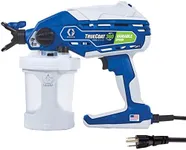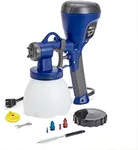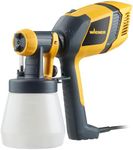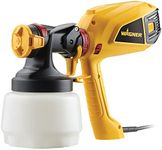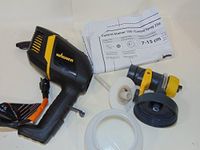Buying Guide for the Best Handheld Paint Sprayers
Choosing a handheld paint sprayer can make painting projects faster and give you a smoother finish compared to brushes or rollers. The right sprayer for you depends on the type of projects you plan to tackle, the materials you want to spray, and how comfortable you are with handling and cleaning the tool. Understanding the main features will help you pick a sprayer that matches your needs and makes your painting experience easier and more enjoyable.Type of SprayerHandheld paint sprayers generally come in two main types: airless and HVLP (High Volume Low Pressure). Airless sprayers use high pressure to push paint out quickly, making them good for covering large areas fast, but they can be harder to control for detail work. HVLP sprayers use lower pressure, which gives you more control and a finer finish, making them better for smaller projects or detailed work. Think about the size and type of projects you’ll do most often—if you’re painting fences or walls, airless might be best; for furniture or cabinets, HVLP could be a better fit.
Paint Flow ControlPaint flow control lets you adjust how much paint comes out of the sprayer. This is important because too much paint can cause drips and waste, while too little can make coverage uneven. Some sprayers have simple dials or knobs to control the flow, while others may have preset settings. If you plan to work on a variety of projects, look for a sprayer with easy and precise flow control so you can adjust it to match the surface and paint type.
Nozzle Size and AdjustabilityThe nozzle size determines the width and pattern of the spray. Smaller nozzles are good for detail work and thin paints, while larger nozzles handle thicker paints and cover bigger areas faster. Some sprayers come with interchangeable nozzles or adjustable spray patterns (horizontal, vertical, circular), which adds versatility. If you want to use your sprayer for different types of projects, choose one with multiple nozzle options or adjustable patterns.
Paint CompatibilityNot all sprayers can handle every type of paint. Some are designed for thin materials like stains or sealers, while others can spray thicker paints like latex. Using the wrong paint can clog the sprayer or give poor results. Check what types of paint the sprayer is designed for, and think about what you’ll use most often. If you want to spray a variety of materials, look for a model that’s compatible with both thin and thick paints.
Ease of CleaningCleaning a paint sprayer after use is important to keep it working well and to avoid clogs. Some sprayers are easier to take apart and clean than others, and some have features like quick-release parts or cleaning attachments. If you want to save time and effort, look for a sprayer that’s known for easy cleaning, especially if you plan to use it frequently or switch between different paints.
Weight and ErgonomicsSince you’ll be holding the sprayer in your hand, its weight and how comfortable it feels are important. Lighter sprayers are easier to use for longer periods, but sometimes heavier models have more power or larger paint containers. Consider how long you’ll be using the sprayer at a time and whether you need something lightweight and easy to grip, especially if you have a lot of painting to do or need to reach overhead.
Paint Container SizeThe size of the paint container affects how often you’ll need to stop and refill. Larger containers let you work longer without stopping, but they can make the sprayer heavier and harder to handle. Smaller containers are lighter and easier to maneuver, but you’ll need to refill more often. Think about the size of your typical projects and whether you prefer fewer interruptions or a lighter tool.
